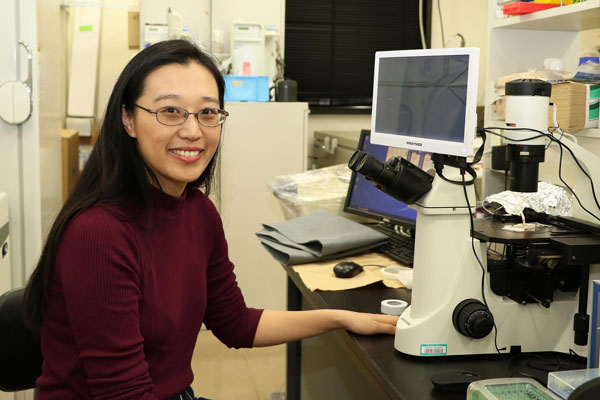Jul. 3, 2020
Microfluidics that shape drug delivery
Leung Hei Man, Special Postdoctoral Researcher

Nano Medical Engineering Laboratory, RIKEN Cluster for Pioneering Research
Describe your role at RIKEN.
I joined the Nano Medical Engineering Laboratory at RIKEN as a Special Postdoctoral Researcher in 2019. My current goal is to develop a new drug-delivery system by controlling the size and shape of drug carriers using microfluidic devices.
Please briefly describe your current research.
Drug-delivery agents are used to enhance the specificity and stability of drug molecules. However, the physical properties of the drug carrier may influence its cellular uptake. To control this, I’m currently developing a microfluidic system that allows the manipulation of a microgel carrier’s size and shape.
How did you become interested in your current field?
I was working on polymer nanoparticles for drug delivery as part of my PhD and I soon realized the limitation on manipulating the size and shape of nanoparticles created by batch-top synthesis. I then became interested in microfluidics for nanoparticle synthesis.

What excites you the most about your current research?
Turning my design into a working device gives me a great sense of achievement. I really enjoy observing my device under a microscope and seeing how microgels are formed in it.
What made you decide to become a scientist?
When I was young, I never dreamed I would become a scientist. However, I enjoy doing experiments, including designing an experiment, testing a hypothesis, and collecting and analyzing data.
What has been the most interesting discovery in your field in the last few years?
To me, the most interesting advances have been organs-on-chips, specially engineered microfluidic culture devices that recreate the microarchitecture and functions of living human organs. Currently, many of the beneficial effects of drug carriers observed in vitro aren’t observed in vivo. I think organs-on-chips can improve this by providing a new observation platform in addition to conventional cell culture experiments and animal studies.
What RIKEN technologies and facilities do you use?
I often use the clean room facility at the Emergent Matter Science Research Laboratory to fabricate microfluidic devices. Here, I use the maskless ultraviolet photolithography system to make devices with channels at a micrometer scale. Also, I use a surface profiler to characterize the geometry of my channel. In addition, I wouldn’t be able to even start my research without the help and support of technicians.
What is the best thing about working at RIKEN?
Being encouraged to do interdisciplinary research. Following my drug carrier fabrication and synthesis work, I am expecting to carry out cell uptake experiments to evaluate the performance of my carriers. Although I have little experience with cell experiments, I’m looking forward to learning about this from other researchers at RIKEN.
